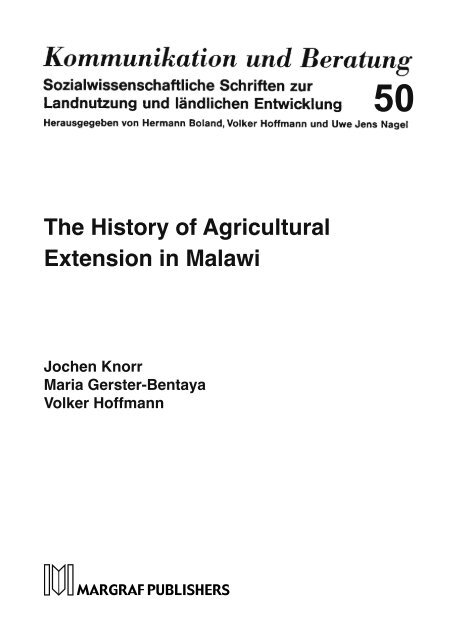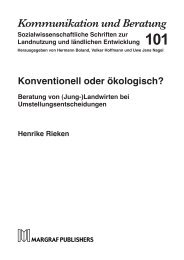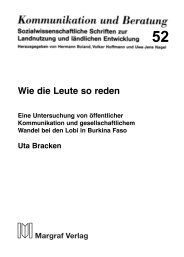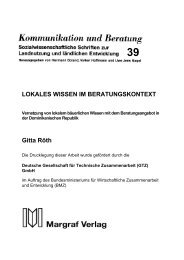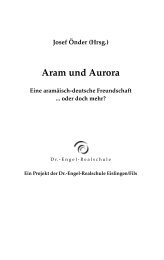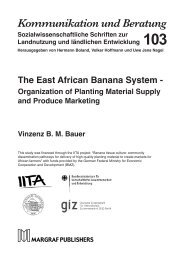The History of Agricultural Extension in Malawi
The History of Agricultural Extension in Malawi
The History of Agricultural Extension in Malawi
You also want an ePaper? Increase the reach of your titles
YUMPU automatically turns print PDFs into web optimized ePapers that Google loves.
<strong>The</strong> <strong>History</strong> <strong>of</strong> <strong>Agricultural</strong><br />
<strong>Extension</strong> <strong>in</strong> <strong>Malawi</strong><br />
Jochen Knorr<br />
Maria Gerster-Bentaya<br />
Volker H<strong>of</strong>fmann<br />
MARGRAF PUBLISHERS<br />
50
Jochen Knorr, Maria Gerster-Bentaya, Volker H<strong>of</strong>fmann<br />
<strong>The</strong> <strong>History</strong> <strong>of</strong> <strong>Agricultural</strong> <strong>Extension</strong> <strong>in</strong> <strong>Malawi</strong><br />
Herausgegeben von<br />
Hermann Boland, Volker H<strong>of</strong>fmann und Uwe Jens Nagel<br />
Bibliographic <strong>in</strong>formation published by „Die Deutsche Bibliothek“<br />
Die Deutsche Bibliothek lists this publication <strong>in</strong> the Deutsche Nationalbibliografie;<br />
detailed bibliographic data is available <strong>in</strong> the Internet at<br />
http://dnb.ddb.de.<br />
Satz und Layout<br />
Maria Gerster-Bentaya, Volker H<strong>of</strong>fmann, Andrea Mayer<br />
Grafiken<br />
Jochen Knorr, Maria Gerster-Bentaya<br />
Druck und B<strong>in</strong>dung<br />
f.u.t. müllerbader gmbh, Filderstadt<br />
© Margraf Publishers GmbH, Scientific books, 2007<br />
Kanalstraße 21; D-97990 Weikersheim<br />
www.margraf-verlag.de; <strong>in</strong>fo@margraf-verlag.de<br />
ISBN 978-3-8236-1513-2<br />
ISSN 0947-0352<br />
MARGRAF PUBLISHERS
Preface<br />
This publication is the result <strong>of</strong> efforts made by various persons at different times:<br />
<strong>The</strong> idea was born dur<strong>in</strong>g a collaboration between Willi Ehret and Maria Gerster-Bentaya<br />
who worked together between 1998 and 2000 on a qualification programme on extension<br />
methods for college teachers and tra<strong>in</strong><strong>in</strong>g <strong>of</strong>ficers <strong>of</strong> the Department <strong>of</strong> <strong>Agricultural</strong> <strong>Extension</strong><br />
Services (DAES). <strong>The</strong>y realised the need for acknowledg<strong>in</strong>g the experiences <strong>of</strong><br />
the past extension approaches to understand current attitudes and ongo<strong>in</strong>g procedures.<br />
<strong>The</strong>y proposed a topic for a master thesis on the history <strong>of</strong> extension <strong>in</strong> <strong>Malawi</strong> and motivated<br />
Jochen Knorr to accept.<br />
After an extensive literature review, Jochen stayed <strong>in</strong> <strong>Malawi</strong> to specifically <strong>in</strong>terview<br />
contemporary witnesses <strong>of</strong> the various extension approaches that have been propagated<br />
and applied s<strong>in</strong>ce the British started with their agricultural promotion programme <strong>in</strong><br />
Nyasaland. Jochen f<strong>in</strong>ished his master thesis <strong>in</strong> autumn 2001. Basically the field study<br />
was a jo<strong>in</strong>t research <strong>of</strong> Mr. Kaliwo and Jochen Knorr. Jochen’s master thesis is the core <strong>of</strong><br />
the publication.<br />
Shortly before and parallel to Jochen’s research stay <strong>in</strong> <strong>Malawi</strong>, the Department <strong>of</strong> <strong>Agricultural</strong><br />
<strong>Extension</strong> worked on the reform <strong>of</strong> the current extension system and drafted the<br />
discussion paper “<strong>Agricultural</strong> <strong>Extension</strong> <strong>in</strong> the New Millennium – Towards Pluralistic<br />
and Demand-driven Services <strong>in</strong> <strong>Malawi</strong>”. In the frame <strong>of</strong> the decentralisation process, extension<br />
should be devolved to the districts and <strong>in</strong>volve all stakeholders. <strong>The</strong> central level<br />
should only play a support<strong>in</strong>g role.<br />
Meanwhile the reform <strong>of</strong> the <strong>Malawi</strong> Governmental <strong>Extension</strong> Service has entered its<br />
seventh year. Additional activities to put the new approach <strong>in</strong>to practice have taken place.<br />
Specifically to set up the District <strong>Extension</strong> Service Systems is still a huge challenge for<br />
all the people <strong>in</strong>volved: new roles have to be accepted, old habits have to be unlearned,<br />
new attitudes and skills have to be acquired.<br />
<strong>The</strong> aspiration to publish the experiences with <strong>in</strong>formation about past extension approaches<br />
became aga<strong>in</strong> more vital <strong>in</strong> 2006, and we decided to add the current discussion<br />
and state <strong>of</strong> the art <strong>of</strong> extension worldwide, and to <strong>in</strong>clude also aveailable material about<br />
the actual state <strong>of</strong> implementation and some experiences with the “new approach” <strong>in</strong> <strong>Malawi</strong>.<br />
<strong>The</strong>refore, the period covered here is from around 1900 until 2007.<br />
<strong>The</strong> <strong>in</strong>terest to publish this book was further stimulated by global changes <strong>of</strong> the very last<br />
years, <strong>in</strong>dicat<strong>in</strong>g a turn<strong>in</strong>g po<strong>in</strong>t for rural development worldwide, with quickly <strong>in</strong>creas<strong>in</strong>g<br />
demand for land use product and accord<strong>in</strong>gly ris<strong>in</strong>g prices. This “new drive” for agriculture,<br />
improves the frame conditions also for <strong>Malawi</strong> and sheds new light on the chances<br />
<strong>of</strong> the extension reform to succeed, at least as time goes by.<br />
Maria Gerster-Bentaya, Volker H<strong>of</strong>fmann, Hohenheim, December 2007<br />
III
Acknowledgements<br />
Many people contributed to the development <strong>of</strong> this publication, specifically dur<strong>in</strong>g the<br />
stays <strong>of</strong> Jochen Knorr and Maria Gerster-Bentaya <strong>in</strong> <strong>Malawi</strong>, and the editors and authors<br />
are most grateful to them:<br />
First, we thank Dr. Willi Ehret who believes that there is a need for learn<strong>in</strong>g from history.<br />
He was the adviser <strong>of</strong> the <strong>Agricultural</strong> <strong>Extension</strong> Support Project (AES) who accompanied<br />
the Department’s process towards “Pluralistic and Demand Driven Services <strong>in</strong> <strong>Malawi</strong>”.<br />
We thank him for his helpfulness and support, for provid<strong>in</strong>g all the project facilities<br />
to Jochen Knorr and who impresses by susta<strong>in</strong>ably <strong>in</strong>corporat<strong>in</strong>g the pr<strong>in</strong>ciples <strong>of</strong> participatory<br />
assistance <strong>in</strong>to the different projects <strong>of</strong> his many years work <strong>in</strong> <strong>Malawi</strong>. He also<br />
helped us to keep up with the recent developments <strong>in</strong> <strong>Malawi</strong> concern<strong>in</strong>g agriculture and<br />
it’s knowledge system s<strong>in</strong>ce the time <strong>of</strong> Jochen Knorr’s field research.<br />
To Dan Kamputa we extend our s<strong>in</strong>cere thanks. When start<strong>in</strong>g the research he was the responsible<br />
Director <strong>of</strong> the Department <strong>of</strong> <strong>Agricultural</strong> <strong>Extension</strong> Services at the M<strong>in</strong>istry<br />
<strong>of</strong> Agriculture. He made the research possible and assisted and supported <strong>in</strong> numerous<br />
ways. Also, we are most grateful for the help <strong>of</strong> all AES Project staff.<br />
Dur<strong>in</strong>g their time at Bunda College many people helped to adjust to liv<strong>in</strong>g and work<strong>in</strong>g <strong>in</strong><br />
<strong>Malawi</strong> and by shar<strong>in</strong>g their knowledge with Jochen and Maria. We especially wish to<br />
express our gratitude to Pr<strong>of</strong>essor Masangano and Mr. Mphepo.<br />
Jochen is most grateful for the help and assistance <strong>of</strong> Mr. Kaliwo who accompanied him<br />
dur<strong>in</strong>g the field study as “<strong>in</strong>terpreter”. He not only translated, but also helped him to get a<br />
deeper <strong>in</strong>sight <strong>in</strong> many issues affect<strong>in</strong>g farmers and extension <strong>in</strong> <strong>Malawi</strong>.<br />
We would like to convey our utmost gratitude to all people <strong>of</strong> the visited EPAs, RDPs and<br />
ADDs, who contributed much with their time, experiences and knowledge about extension.<br />
In all the EPAs we received a warm welcome and were supported as much as possible.<br />
Furthermore we wish to express our gratitude to the staff <strong>of</strong> various NGOs and farmer<br />
organisations; they helped us much by giv<strong>in</strong>g <strong>in</strong>sight <strong>in</strong>to their work.<br />
We wish to extend our gratitude to all farmers who took their time to answer the questions<br />
and to give us <strong>in</strong>sight <strong>in</strong>to their problems and their way <strong>of</strong> life. It was a privilege to visit<br />
the villages and to spend time with people who have such a different background. We do<br />
hope that the farmers´ time was not spent <strong>in</strong> va<strong>in</strong>, but that this work contributes to improve<br />
their situation.<br />
Last but not least, Jochen Knorr wants to thank his wife Christiane, who encouraged him<br />
through the duration <strong>of</strong> his research. She was so patient, especially <strong>in</strong> shar<strong>in</strong>g his sorrows<br />
dur<strong>in</strong>g the write-up <strong>of</strong> the MSc <strong>The</strong>sis <strong>in</strong> Germany.<br />
We also want to thank all personnel from the Department <strong>of</strong> <strong>Agricultural</strong> <strong>Extension</strong> and<br />
Communication Science at the University <strong>of</strong> Hohenheim, Germany, especially Patrick<br />
Groetz and Simone Kriesemer for advice regard<strong>in</strong>g the content <strong>of</strong> this study.<br />
Jochen Knorr, Maria-Gerster Bentaya, Volker H<strong>of</strong>fmann<br />
IV
Table <strong>of</strong> Contents<br />
Preface ............................................................................................................................... III<br />
Aknowledgements.............................................................................................................. IV<br />
Table <strong>of</strong> Contents ................................................................................................................ V<br />
List <strong>of</strong> Boxes, Figures, Tables ........................................................................................ VIII<br />
Abbreviations and Acronyms............................................................................................. IX<br />
1 Introduction........................................................................................................ 1<br />
1.1 Problem Statement .................................................................................................. 1<br />
1.2 Objectives................................................................................................................ 1<br />
2 Overall Methodology and the Field Study <strong>in</strong> <strong>Malawi</strong>......................... 3<br />
2.1 Methodology ........................................................................................................... 3<br />
2.2 Empirical Methods Used......................................................................................... 5<br />
2.2.1 Unstructured Interviews.......................................................................................... 5<br />
2.2.2 Semi-structured Interviews ..................................................................................... 5<br />
2.3 Steps <strong>of</strong> the Empirical Field Study <strong>in</strong> <strong>Malawi</strong>........................................................ 6<br />
2.3.1 Selection <strong>of</strong> Research Areas ................................................................................... 6<br />
2.3.2 Conduct<strong>in</strong>g the Field Study..................................................................................... 8<br />
3 <strong>Agricultural</strong> <strong>Extension</strong>................................................................................. 10<br />
3.1 <strong>The</strong> Emergence <strong>of</strong> <strong>Agricultural</strong> <strong>Extension</strong> <strong>in</strong> Europe and <strong>in</strong> the USA................. 10<br />
3.2 Def<strong>in</strong>itions <strong>of</strong> <strong>Agricultural</strong> <strong>Extension</strong>................................................................... 12<br />
3.3 Some basic Concepts for <strong>Extension</strong>...................................................................... 15<br />
3.4 Elements <strong>of</strong> an <strong>Extension</strong> Approach..................................................................... 19<br />
3.5 Experiences with <strong>Extension</strong> <strong>in</strong> Sub-Saharan Africa ............................................. 20<br />
4 <strong>Malawi</strong>................................................................................................................. 24<br />
4.1 Geography and Climate ........................................................................................ 24<br />
4.2 Socio-economic Situation ..................................................................................... 24<br />
4.3 Agriculture ............................................................................................................ 26<br />
5 Historical Developments ............................................................................ 28<br />
5.1 A Short <strong>History</strong> <strong>of</strong> <strong>Malawi</strong>.................................................................................... 28<br />
5.1.1 Pre-colonial Time.................................................................................................. 28<br />
5.1.2 <strong>The</strong> Colonial Time ................................................................................................ 29<br />
5.1.3 Transition and Independence ................................................................................ 30<br />
V
5.1.4 <strong>Malawi</strong> under Banda ............................................................................................. 31<br />
5.1.5 Political Change Dur<strong>in</strong>g the 90’s and Beyond...................................................... 32<br />
5.2 <strong>History</strong> <strong>of</strong> <strong>Agricultural</strong> Policy .............................................................................. 33<br />
5.2.1 <strong>Agricultural</strong> Policy <strong>in</strong> the Protectorate ................................................................. 33<br />
5.2.2 <strong>Agricultural</strong> Policy <strong>in</strong> Post-War Nyasaland and the Central African<br />
Federation.............................................................................................................. 34<br />
5.2.3 Post-<strong>in</strong>dependence <strong>Agricultural</strong> Policy and the Four Major Integrated<br />
Rural Development Projects ................................................................................. 37<br />
5.2.4 <strong>Agricultural</strong> Policy <strong>in</strong> the 1980s and 1990s.......................................................... 41<br />
5.2.5 <strong>Agricultural</strong> Policy between 2000 and 2006......................................................... 43<br />
6 <strong>Malawi</strong>’s Past <strong>Extension</strong> Approaches................................................... 51<br />
6.1 “Early” Colonial <strong>Extension</strong>................................................................................... 51<br />
6.2 “Coercion and Compulsion” ................................................................................. 52<br />
6.3 <strong>The</strong> Master Farmer Approach............................................................................... 54<br />
6.4 Education and Persuasion ..................................................................................... 55<br />
6.5 <strong>The</strong> New Master Farmer Scheme: Achikumbi ..................................................... 57<br />
6.6 Farmer Clubs and the Group Approach................................................................ 58<br />
6.7 Package Programmes ............................................................................................ 59<br />
7 <strong>The</strong> Block <strong>Extension</strong> System (BES)....................................................... 61<br />
7.1 Tra<strong>in</strong><strong>in</strong>g & Visit (T&V)........................................................................................ 61<br />
7.2 <strong>The</strong> Block <strong>Extension</strong> System <strong>in</strong> the 80’................................................................ 63<br />
7.2.1 Salient Features <strong>of</strong> the BES .................................................................................. 63<br />
7.2.2 Advantages and Disadvantages <strong>of</strong> the BES <strong>in</strong> the 80’s ........................................ 65<br />
7.3 New Developments <strong>in</strong> <strong>Malawi</strong>’s <strong>Extension</strong> Dur<strong>in</strong>g the 90’s ............................... 66<br />
7.3.1 Modifications and Changes <strong>of</strong> the BES................................................................ 66<br />
7.3.2 New Challenges .................................................................................................... 68<br />
7.3.3 New <strong>Extension</strong> Providers...................................................................................... 69<br />
8 Experiences with <strong>Extension</strong>, assessed <strong>in</strong> 2001................................ 71<br />
8.1 <strong>Agricultural</strong> <strong>Extension</strong> <strong>in</strong> the Area <strong>of</strong> Karonga .................................................... 71<br />
8.1.1 Farmers’ Experiences with <strong>Extension</strong> <strong>in</strong> Kaporo South EPA .............................. 71<br />
8.1.2 <strong>Extension</strong> Providers <strong>in</strong> Kaporo South EPA .......................................................... 74<br />
VI
8.2 <strong>Agricultural</strong> <strong>Extension</strong> <strong>in</strong> the Area <strong>of</strong> Salima....................................................... 75<br />
8.2.1 Farmers’ <strong>Extension</strong> Experiences <strong>in</strong> Tembwe EPA............................................... 75<br />
8.2.2 <strong>Extension</strong> Providers <strong>in</strong> Tembwe EPA................................................................... 77<br />
8.3 <strong>Agricultural</strong> <strong>Extension</strong> <strong>in</strong> the Area <strong>of</strong> Mulanje..................................................... 78<br />
8.3.1 Farmers’ <strong>Extension</strong> Experiences <strong>in</strong> Mulanje Boma EPA..................................... 78<br />
8.3.2 <strong>Extension</strong> Providers <strong>in</strong> Mulanje Boma EPA......................................................... 80<br />
8.4 Experiences <strong>of</strong> Current and Retired Staff ............................................................. 81<br />
8.4.1 <strong>The</strong> Strengths and Weaknesses <strong>of</strong> Past <strong>Extension</strong> Approaches............................ 82<br />
8.4.2 <strong>The</strong> BES <strong>in</strong> the Eyes <strong>of</strong> Frontl<strong>in</strong>e <strong>Extension</strong> Staff ............................................... 82<br />
8.4.3 NGOs and the Public <strong>Extension</strong> Service .............................................................. 84<br />
9 New Developments <strong>in</strong> <strong>Agricultural</strong> <strong>Extension</strong>................................... 86<br />
9.1 New Trends <strong>in</strong> <strong>Extension</strong> Worldwide................................................................... 86<br />
9.1.1 De-l<strong>in</strong>k<strong>in</strong>g Provision and Fund<strong>in</strong>g <strong>of</strong> <strong>Extension</strong> .................................................. 87<br />
9.1.2 Common Framework <strong>of</strong> <strong>Agricultural</strong> <strong>Extension</strong>: <strong>The</strong> Neuchâtel Initiative ......... 87<br />
9.1.3 F<strong>in</strong>ance Mechanisms............................................................................................. 89<br />
9.1.4 Accountability for Empowerment......................................................................... 91<br />
9.2 <strong>Malawi</strong>’s New <strong>Extension</strong> Policy and System ....................................................... 91<br />
9.2.1 Driv<strong>in</strong>g forces for a change................................................................................... 91<br />
9.2.2 <strong>The</strong> New <strong>Extension</strong> Policy.................................................................................... 92<br />
9.2.3 <strong>The</strong> actual adm<strong>in</strong>istrative set-up and responsibilities ........................................... 95<br />
9.2.4 <strong>The</strong> District <strong>Agricultural</strong> <strong>Extension</strong> Services System .......................................... 96<br />
9.2.5 What happens to render the new DAESS operational? ........................................ 99<br />
10 Outlook ............................................................................................................ 100<br />
11 Summaries ..................................................................................................... 101<br />
11.1 Summary ............................................................................................................. 101<br />
11.1 Zusammenfassung............................................................................................... 103<br />
12 Bibliography ...........................................................................................................107<br />
13 Annexes ....................................................................................................................114<br />
13.1 List <strong>of</strong> Interviews ................................................................................................ 114<br />
13.2 Interview Guidel<strong>in</strong>es........................................................................................... 116<br />
VII
List <strong>of</strong> Boxes, Figures and Tables<br />
Box 1: <strong>Malawi</strong>’s Vision 2020....................................................................................... 46<br />
Box 2: Summary <strong>of</strong> achievements <strong>in</strong> extension services ............................................. 47<br />
Box 3: “Master Farmers <strong>of</strong> Nyasaland”......................................................................... 55<br />
Box 4: What is a f<strong>in</strong>anc<strong>in</strong>g mechanism? ....................................................................... 90<br />
Figure 1: Map <strong>of</strong> <strong>Malawi</strong> with the Research Locations..................................................... 7<br />
Figure 2: Framework Model <strong>of</strong> Organised <strong>Extension</strong> ..................................................... 16<br />
Figure 3: Model <strong>of</strong> the Psychological Field..................................................................... 17<br />
Figure 4: Model <strong>of</strong> Behaviour Modification.................................................................... 17<br />
Figure 5: Stages <strong>of</strong> Systematic Problem Solv<strong>in</strong>g............................................................. 18<br />
Figure 6: What an <strong>Extension</strong> Approach Should Conta<strong>in</strong>................................................. 19<br />
Figure 7: Map <strong>of</strong> <strong>Malawi</strong> ................................................................................................. 25<br />
Figure 8: Location <strong>of</strong> the Integrated Rural Development Projects <strong>in</strong> 1974..................... 39<br />
Figure 9 <strong>The</strong> <strong>Agricultural</strong> Development Divisions......................................................... 42<br />
Figure 10: One Village One Product (OVOP) <strong>in</strong> <strong>Malawi</strong>, as <strong>of</strong> July 2007 ....................... 49<br />
Figure 11: Percentage <strong>of</strong> total cotton and tobacco produced by white farmers <strong>in</strong><br />
colonial <strong>Malawi</strong>, 1920-1940............................................................................ 51<br />
Figure 12 <strong>Extension</strong> as Bridge .......................................................................................... 52<br />
Figure 13: <strong>The</strong> Transfer Model.......................................................................................... 62<br />
Figure 14: Mixed strategies for f<strong>in</strong>anc<strong>in</strong>g and provid<strong>in</strong>g extension .................................. 87<br />
Figure 15: Possibilities <strong>of</strong> Channell<strong>in</strong>g F<strong>in</strong>ances............................................................... 90<br />
Figure 16: Accountability <strong>in</strong> extension.............................................................................. 91<br />
Figure 17: <strong>The</strong> Stakeholder Panel...................................................................................... 98<br />
Table 1: Research Timetable ............................................................................................ 4<br />
Table 2: Targeted Input Programs .................................................................................. 46<br />
Table 3: Active World Bank Projects <strong>in</strong> <strong>Malawi</strong> as <strong>of</strong> 2007.......................................... 48<br />
Table 4: Strengths and Weaknesses <strong>of</strong> Past <strong>Extension</strong> Approaches............................... 82<br />
VIII
Abbreviations and Acronyms<br />
ADD <strong>Agricultural</strong> Development Division<br />
ADF African Development Fund<br />
ADMARC <strong>Agricultural</strong> Development and Market<strong>in</strong>g Corporation<br />
AFORD Alliance for Democracy<br />
ARET <strong>Agricultural</strong> Research and <strong>Extension</strong> Trust<br />
ASAC <strong>Agricultural</strong> Sector Adjustment Credit<br />
ASP <strong>Agricultural</strong> Service Project<br />
BCAP British Central Africa Protectorate<br />
BES Block <strong>Extension</strong> System<br />
BMZ German M<strong>in</strong>istry for Economic Co-Operation<br />
CFSME Conscientisation, Formation, Stimulation, Moyens, Evaluation<br />
COSPE Co-operation for the Development <strong>of</strong> Emerg<strong>in</strong>g Countries<br />
CU Concern Universal (NGO)<br />
CSC Christian Service Committee<br />
DAES Department <strong>of</strong> <strong>Agricultural</strong> <strong>Extension</strong> Services<br />
DANIDA Danish International Development Agency<br />
DAO District <strong>Agricultural</strong> Officer<br />
DO Development Officer<br />
ECGC Empire Cotton Grow<strong>in</strong>g Corporation<br />
EDF European Development Fund<br />
EPA <strong>Extension</strong> Plann<strong>in</strong>g Area<br />
FA Field Assistant<br />
FAO Food and Agriculture Organization<br />
FBO Farmer-based Organisation<br />
FFS Farmers’ Field School (<strong>Extension</strong> Approach)<br />
FtF Farmer to Farmer (<strong>Extension</strong> Approach)<br />
GDP Gross Domestic Product<br />
GNP Gross National Product<br />
GRAAP Groupe de Recherche et d’Appui à l’Autopromotion Paysanne<br />
GTZ German Agency for Technical Cooperation<br />
HIV/AIDS Human Immunodeficiency Virus / Acquired Immune Deficiency Syndrome<br />
IDA International Development Association<br />
IFAD International Fund for <strong>Agricultural</strong> Development<br />
IMF International Monetary Fund<br />
IRDP Integrated Rural Development Project<br />
JICA Japan International Cooperation Agency<br />
MAEPS <strong>Agricultural</strong> <strong>Extension</strong> and Plann<strong>in</strong>g Support Project<br />
IX
MARE <strong>Malawi</strong> <strong>Agricultural</strong> Research and <strong>Extension</strong> Project<br />
MASIP <strong>Malawi</strong> <strong>Agricultural</strong> Sector Investment Programme<br />
MCP <strong>Malawi</strong> Congress Party<br />
MGDS <strong>Malawi</strong> Growth and Development Strategy<br />
MK <strong>Malawi</strong> Kwacha, National Currency<br />
MoA M<strong>in</strong>istry <strong>of</strong> Agriculture<br />
MoAFS M<strong>in</strong>istry <strong>of</strong> Agriculture and Food Security<br />
MoAI M<strong>in</strong>istry <strong>of</strong> Agriculture and Irrigation<br />
MPRSP <strong>Malawi</strong> Strategy Reduction Strategy Paper<br />
NAC Nyasaland African Congress<br />
NARP National <strong>Agricultural</strong> Research Project<br />
NASFAM National Smallholder Farmer Association <strong>of</strong> <strong>Malawi</strong><br />
NGO Non Governmental Organisation<br />
NRDP National Rural Development Programme<br />
OPM Oxford Policy Management<br />
OVOP One Village One Product<br />
PEM Participatory <strong>Extension</strong> Methods<br />
PJO Project Officer<br />
PM Programme Manager<br />
PRA Participatory Rural Appraisal<br />
PROSCARP Promotion <strong>of</strong> Soil Conservation and Rural Production Project (NGO)<br />
PRSP Poverty Reduction Strategy Paper<br />
RDP Rural Development Project<br />
RTC Residential Tra<strong>in</strong><strong>in</strong>g Centre<br />
SAL Structural Adjustment Loan<br />
SAP Structural Adjustment Programme<br />
SMS Subject Matter Specialist<br />
SG 2000 Sasakawa Global 2000<br />
SWAp Sector-Wide Approach<br />
T&V Tra<strong>in</strong><strong>in</strong>g and Visit <strong>Extension</strong> System<br />
TIP Targeted Input Programme<br />
TOT Transfer <strong>of</strong> Technology<br />
UDF United Democratic Front<br />
UNDP United Nations Development Programme<br />
UNICEF United Nations Children’s Fund<br />
USAID United States Agency for International Development<br />
VLPA Village Level Participatory Approach<br />
X


